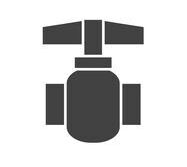 Chemical disinfection, primarily through the use of chlorine compounds, kills microorganisms in medical waste and can oxidize hazardous chemical constituents. Chlorine bleach has been used for disinfecting processes for years – you might use it to clean your underwear and kill the e.coli. Chlorine compounds are used in swimming pools to reduce the risk of disease transmission. Ethylene oxide treatment is another chemical process. It is used to disinfect or sterilize materials equipment that will be reused. It is too expensive to use on equipment or waste that will be sent to a landfill - incineration is better.
Chemical disinfection, primarily through the use of chlorine compounds, kills microorganisms in medical waste and can oxidize hazardous chemical constituents. Chlorine bleach has been used for disinfecting processes for years – you might use it to clean your underwear and kill the e.coli. Chlorine compounds are used in swimming pools to reduce the risk of disease transmission. Ethylene oxide treatment is another chemical process. It is used to disinfect or sterilize materials equipment that will be reused. It is too expensive to use on equipment or waste that will be sent to a landfill - incineration is better.
Both mechanical grinding and chemical processes are usually batch processes – which you may think of as similar to a washing machine at the laundromat. They can be run in fixed batch sizes and consistent processing times. Liquid  medical waste is often best treated with chemicals, if the medical waste is aqueous; organic liquid waste does not mix well with bleach. But most liquid medical waste is aqueous.
medical waste is often best treated with chemicals, if the medical waste is aqueous; organic liquid waste does not mix well with bleach. But most liquid medical waste is aqueous.
The EPA identifies chemical processing as the most appropriate method to treat liquid medical waste. Treated liquid waste can usually be discharged into the sewer system. Sometimes it goes to a holding tank for testing before discharge.
There are many oxidants on the market. They can be used for liquid waste but can also be used for treatment of slurries and sludges. They may be best for low organic content waste as organic material will eat up the oxidant. The same oxidants are used to treat waste as are used for disinfection.
Reduction is the flip side to oxidation, but in treatment it is less common than oxidation. One waste constituent treated by reduction is heavy metals ions, which are converted to a less toxic form or to precipitate
Potassium permanganate - purchased as purple crystals. Mixed with wet waste to oxidize constituents.
| Temp, C | Solubility, g/L |
| 0 | 28 |
| 20 | 65 |
| 40 | 125 |
| 60 | 230 |
| 80 | 350 |
| 100 | 500 |
Calcium hypochlorite Ca(OCl)sub>2
Contains 65 percent available chlorine. Sold as solid tablets or granular. Can be purchased from the pool supply store and industrial suppliers. Comes in 50, 75, and 100 lb fiber drums.
Hydrogen peroxide
Sold at 30 to 70 percent concentration. Special handling required, especially for high concentration solutions. Can decompose if impurities present in storage. Often sold with inhibitors mixed in so no decomposition.
Properties of 50 percent H2O2
Active oxygen, 23.5 wt percent
600 grams of H2O2 per liter
Density = 1.2 g/l
Boiling point = 237 °F
Freezing point = -62 °F
Hydrogen peroxide comes in 30- or 55-gal drums and in bulk in large tankers.
Sodium hypochlorite NaOCl
Sold in aqueous solution - "bleach". Available chlorine = measure of oxidizing power of active chlorine compared to elemental chlorine. This is not the same as concentration. 5.25 percent NaOCl has 5.0 percent available chlorine.
Sodium Borohydride
NaBH4
Sold as 12 percent solution in 40 percent sodium hydroxide
Density is 1.4 g/ml
Sulfur Dioxide and Ferrous Sulfate are also reduction agents.
Aqueous solutions can be brought to a more desirable pH with either acid (e.g. sulfuric) or base (e.g. sodium hydroxide) solutions. A system would consist of storage and mixing tanks as well as agitators. Dosing pumps are typically deployed in a “1+1” arrangement (1 operating +1 standby) and area centrifugal or positive displacement pumps. Neutralization tanks are often in a 3+1 configuration (3 operating and 1 standby), 5+1 configuration or 7+1 configuration.
Physically, an ion exchange contactor has components similar to a sandfilter, with resin used instead of sand, and with all the components required for media support, influent distribution, effective bed use, and treated water collection. The big difference being that inplace regeneration is required.
Basically, an ion exchange unit must include
As with sand filters, exchangers can be gravity or pressure fed, although pressure systems are commonly employed. They can also be operated as an upflow or downflow process, with downflow systems acting as a filter and exchanger. Ion exchanger vessels are commonly pressurized vertical steel vessels, lined to provide corrosion protection from the regeneration chemicals. Stainless steel and reinforced plastic can be used for some processes.
Ion exchange is a comparatively simple treatment system with most operating variables related to flow rate. When the system is automated, limited operator attention is required. Total influent dissolved solids are limited to about 1000 mg/L. Columns must be regenerated periodically and the frequency affects operating costs.
Ion exchange may be considered a special case of adsorption. Major differences include resin characteristics and selection, and regeneration method. Specific ion exchange process concerns include system configuration. exchanger duty, resin selectivity, and contactor depth and diameter.
